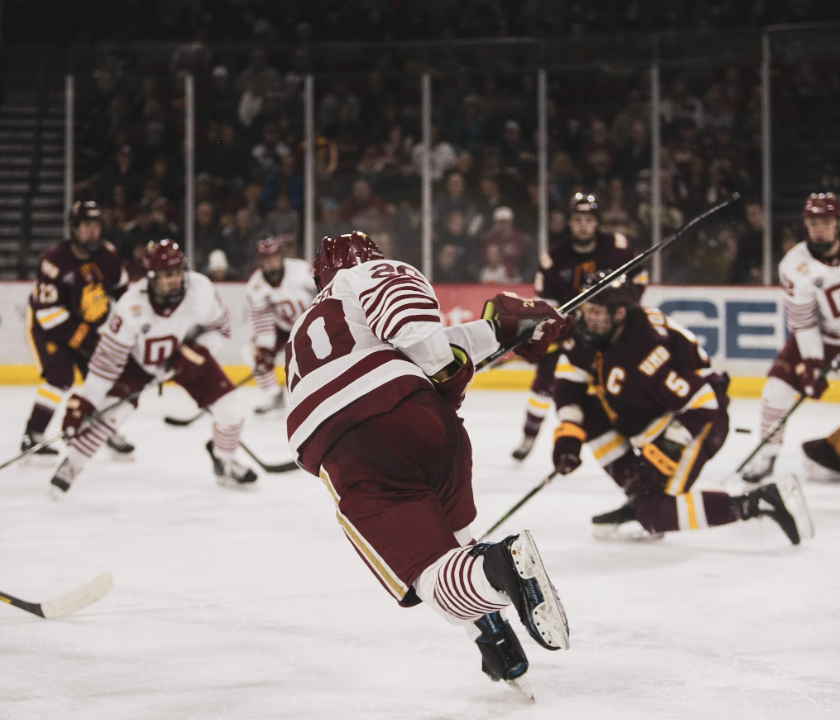Are Ice Hockey Games Cold? Yes, ice hockey games are cold. The ice rink is kept at low temperatures to maintain the ice surface.
Ice hockey games occur in cold environments due to the need to keep the ice solid. Rinks are typically maintained at temperatures between 24°F to 26°F (-4°C to -3°C). Spectators should dress warmly, as the cold air can be brisk, even with a large crowd.
Layers, hats, and gloves can help keep you comfortable during the game. While the chill adds to the authentic experience of an ice hockey match, being prepared ensures you can fully enjoy the excitement and fast-paced action on the ice. The cold is part of the thrill whether you’re a fan or a first-time attendee.
The Arena Environment
Stepping into an ice hockey arena can feel like entering a different world. The atmosphere is excited, and the temperature can be noticeably more relaxed. Understanding the arena environment can enhance your experience and prepare you for the chill.
Temperature Standards
Ice hockey arenas maintain specific temperatures to keep the ice in top condition. The air temperature is usually kept between 50°F and 60°F (10°C to 15°C), ensuring the ice remains solid and smooth. These cooler temperatures also help keep the players comfortable as they exert themselves during the game.
Here is a quick overview:
| Factor | Temperature Range |
|---|---|
| Air Temperature | 50°F – 60°F (10°C – 15°C) |
| Ice Temperature | 24°F – 26°F (-4°C – -3°C) |
Cooling Systems At Play
Maintaining these temperatures requires advanced cooling systems. Most arenas use a brinewater system under the ice surface. Brinewater is a saltwater solution that helps keep the ice cold. Pipes filled with this solution run beneath the ice, absorbing heat and keeping the surface frozen.
Here’s how the cooling system works:
- A refrigeration plant cools the brinewater.
- The chilled brine water circulates through pipes under the ice.
- Heat is absorbed from the ice, maintaining its frozen state.
These systems are crucial for ensuring the ice remains in perfect condition throughout the game. This process also helps regulate the arena’s overall temperature, creating a comfortable environment for spectators.
Next time you attend an ice hockey game, you’ll understand why it feels so cold. The precise temperature control ensures an optimal experience for both players and fans.
Credit: rinkresult.com
Player Perspectives
Ice hockey players experience unique challenges on the ice. Their perspectives offer insights into game conditions. Players deal with the cold in different ways.
Gear And Body Heat
Ice hockey players wear specific gear. This gear helps them stay warm. Equipment includes helmets, gloves, and padded uniforms.
Helmets protect their heads and keep warmth in. Gloves shield hands from the cold. Padded uniforms cover the body and add warmth.
Players also generate heat through movement. Skating fast and playing hard increase body temperature. This helps them stay warm during games.
Adapting To The Chill
Players must adapt to the cold rink. They have strategies to stay warm. Stretching before games helps muscles stay loose.
Some players use heating pads. These pads warm up muscles before the game. Others drink warm fluids to keep their bodies heated.
Players also take breaks to warm up. They sit on benches with heaters. This helps them maintain body temperature.
Adapting to the cold is crucial for performance. Players need to stay warm to play their best.
Spectator Experience
Attending an ice hockey game can be an exhilarating experience. The fast-paced action on the ice, the roar of the crowd, and the chill in the air all contribute to the excitement. But one common question among first-time spectators is, “Are ice hockey games cold?” Let’s explore the spectator experience to help you prepare for your next game.
Dressing For The Game
Ice hockey rinks maintain a cool temperature to keep the ice frozen. This means the arena can feel quite chilly. It’s important to dress warmly to stay comfortable during the game. Here are some tips:
- Wear layers: A base layer, a warm sweater, and a jacket work well.
- Bring a hat and gloves: These can help keep you warm, especially if you have cold hands or ears.
- Comfortable shoes: Warm socks and comfortable shoes can make a big difference.
Warmth Amenities In Stadiums
Many stadiums offer amenities to help keep spectators warm. These can enhance your overall experience:
| Amenity | Description |
|---|---|
| Heated Areas | Some arenas have heated sections or lounges for fans. |
| Blanket Rentals | Blankets can often be rented or purchased at the stadium. |
| Hot Beverages | Concession stands usually sell hot drinks like coffee or cocoa. |
These amenities can make a big difference, especially during longer games.
Ice Maintenance
Ice hockey games are thrilling, but the ice needs care. The ice must be smooth and safe. Ice maintenance is crucial for a great game. Let’s dive into how this works.
Optimal Conditions For Play
The ice must be at the right temperature. This ensures it is hard and smooth. The ideal ice temperature is between 24°F and 26°F. If the ice is too warm, it becomes soft and slow. If it is too cold, it can crack easily. Keeping the ice at the right temperature is key for a fast and safe game.
Zamboni’s Role
The Zamboni is a special machine for ice maintenance. It scrapes the ice to remove rough spots. It also sprays a thin layer of water. This water freezes to create a smooth surface. The Zamboni usually cleans the ice between periods. This keeps the ice in top condition for the players.
Impact Of Temperature On Play
Ice hockey games are cold. The temperature impacts how the game is played. Cold temperatures affect the puck and players. Understanding this helps fans and players.
Puck Behavior
The puck’s behavior changes in cold temperatures. A cold puck moves faster and slides more smoothly. It becomes harder and less bouncy. This makes control crucial.
A table can illustrate this well:
| Temperature | Puck Speed | Puck Bounce |
|---|---|---|
| Cold | Fast | Low |
| Warm | Slow | High |
Player Performance
Cold affects player performance too. Players need to stay warm. Staying warm helps them move fast and stay alert. They wear layers under their gear.
Benefits of staying warm:
- Better movement
- Faster reactions
- Less muscle stiffness
Players also need to drink water. Cold air can dehydrate them. Hydration keeps them playing well.
Credit: www.nytimes.com
Behind The Scenes
Ice hockey games are thrilling to watch. But, have you ever wondered what happens behind the scenes? Ice hockey arenas are more than just cold rinks. They have intricate systems to ensure comfort and functionality. Let’s explore the behind-the-scenes aspects of ice hockey games.
Heating Systems For Comfort
Though ice rinks are cold, arenas have heating systems. These systems ensure that spectators stay warm. They use advanced technology to maintain a pleasant temperature.
Most arenas use overhead heaters. These heaters direct warm air towards the seating areas. This keeps fans cozy while they enjoy the game. Some arenas also use under-seat heating. This method distributes warmth directly to where fans are seated.
Here is a table showcasing common heating systems in arenas:
| Heating System | Description |
|---|---|
| Overhead Heaters | Heaters placed above the stands to direct warm air. |
| Under-Seat Heating | Heaters installed under seats to provide direct warmth. |
| Radiant Floor Heating | Heated floors to keep the arena at a comfortable temperature. |
Locker Room Conditions
Locker rooms are essential for player comfort. They need to be warm and clean. Players spend a lot of time here before and after games.
Heating systems in locker rooms are crucial. They ensure players can warm up and stay comfortable. Locker rooms also have ventilation systems. These systems keep the air fresh and remove excess moisture.
Here are some key features of locker room conditions:
- Heating systems to maintain a warm environment.
- Ventilation systems to ensure fresh air circulation.
- Drying racks for equipment to keep it dry and ready for use.
Behind the scenes, these systems play a vital role. They ensure both players and fans have a great experience.
Historical Venues Vs. Modern Arenas
Ice hockey has evolved significantly over the years, especially in terms of venues. The transition from historical venues to modern arenas has brought significant changes. This shift has affected everything from temperature control to fan comfort. Let’s explore these changes in detail.
Evolution Of Temperature Control
Historical ice hockey venues lacked advanced temperature control systems. These venues relied on natural ice, which was challenging to maintain. Fans often experienced extreme cold during games. Modern arenas, however, use sophisticated HVAC systems. These systems ensure optimal ice conditions and comfortable temperatures for fans.
| Aspect | Historical Venues | Modern Arenas |
|---|---|---|
| Ice Maintenance | Natural Ice | Artificial Ice |
| Temperature Control | Basic or None | Advanced HVAC Systems |
| Fan Comfort | Often Cold | Comfortable Temperatures |
Fan Comfort Through The Ages
In the early days of ice hockey, fan comfort was not a priority. Spectators often bundled up in heavy coats and blankets. The cold was a common complaint among fans. Modern arenas have changed this experience dramatically. They offer heated seats, climate control, and other amenities. This ensures fans enjoy the game in comfort.
Here are some features enhancing fan comfort in modern arenas:
- Heated Seats: Fans stay warm even in chilly environments.
- Climate Control: Ensures a consistent temperature throughout the arena.
- Insulated Structures: Prevents cold air from seeping in.
Modern arenas prioritize fan experience. This has led to higher attendance and more enjoyable games. The evolution from historical venues to modern arenas has undoubtedly improved the ice hockey experience for everyone.
Credit: rinkresult.com
Tips For First-time Goers
Attending an ice hockey game for the first time can be exciting. But it can also be quite cold. This guide will help you prepare. You’ll learn what to expect and how to stay warm. Enjoy the game without any worries!
What To Expect
Ice hockey games are held in ice arenas. These places are cold to keep the ice from melting. Expect temperatures to be chilly. It’s like standing in a big fridge.
The atmosphere is lively. Fans cheer loudly. You might see players move quickly across the ice. The game is fast-paced and thrilling. Bring earplugs if you don’t like loud noises.
Staying Warm And Enjoying The Game
Dress in layers. This helps you adjust to the cold. Wear a warm jacket, hat, and gloves. Consider bringing a blanket. Some arenas provide heated seats, but not all. Check ahead to see if your arena does.
Wear thick socks and waterproof boots. The floors can be cold and sometimes wet. Keep your feet warm and dry. This will make your experience much more pleasant.
Here are some items to bring:
- Warm jacket
- Hat and gloves
- Thick socks
- Waterproof boots
- Blanket
- Earplugs
Also, keep moving during breaks. Walk around the arena to stay warm. Enjoy a hot drink like cocoa or coffee. This keeps your hands and body warm.
Stay close to friends or family. Sharing body heat can help. Plus, it’s more fun to watch the game with loved ones.
Frequently Asked Questions
How Cold Is It At An Ice Hockey Game?
The temperature at an ice hockey game is usually between 50-60°F (10-15°C). Dress warmly for comfort.
How Should I Dress For A Hockey Game?
Dress in layers to stay warm. Wear a comfortable jacket, jeans, and closed-toe shoes. Bring a hat and gloves.
Is It Cold When Watching A Hockey Game?
Yes, it can be cold when watching a hockey game. Arenas keep the temperature low to maintain ice quality. Dress warmly.
Why Are Hockey Stadiums Cold?
Hockey stadiums are cold to maintain the ice surface. The low temperature prevents the ice from melting. Players also need a cool environment to perform optimally.
Conclusion
Ice hockey games are indeed cold. Dressing warmly ensures a comfortable experience. Layers, hats, and gloves are essential. Enjoy the thrilling action without feeling the chill. Make the most of your ice hockey game visit by staying warm and cozy.
Embrace the excitement and stay comfortable throughout the game.







